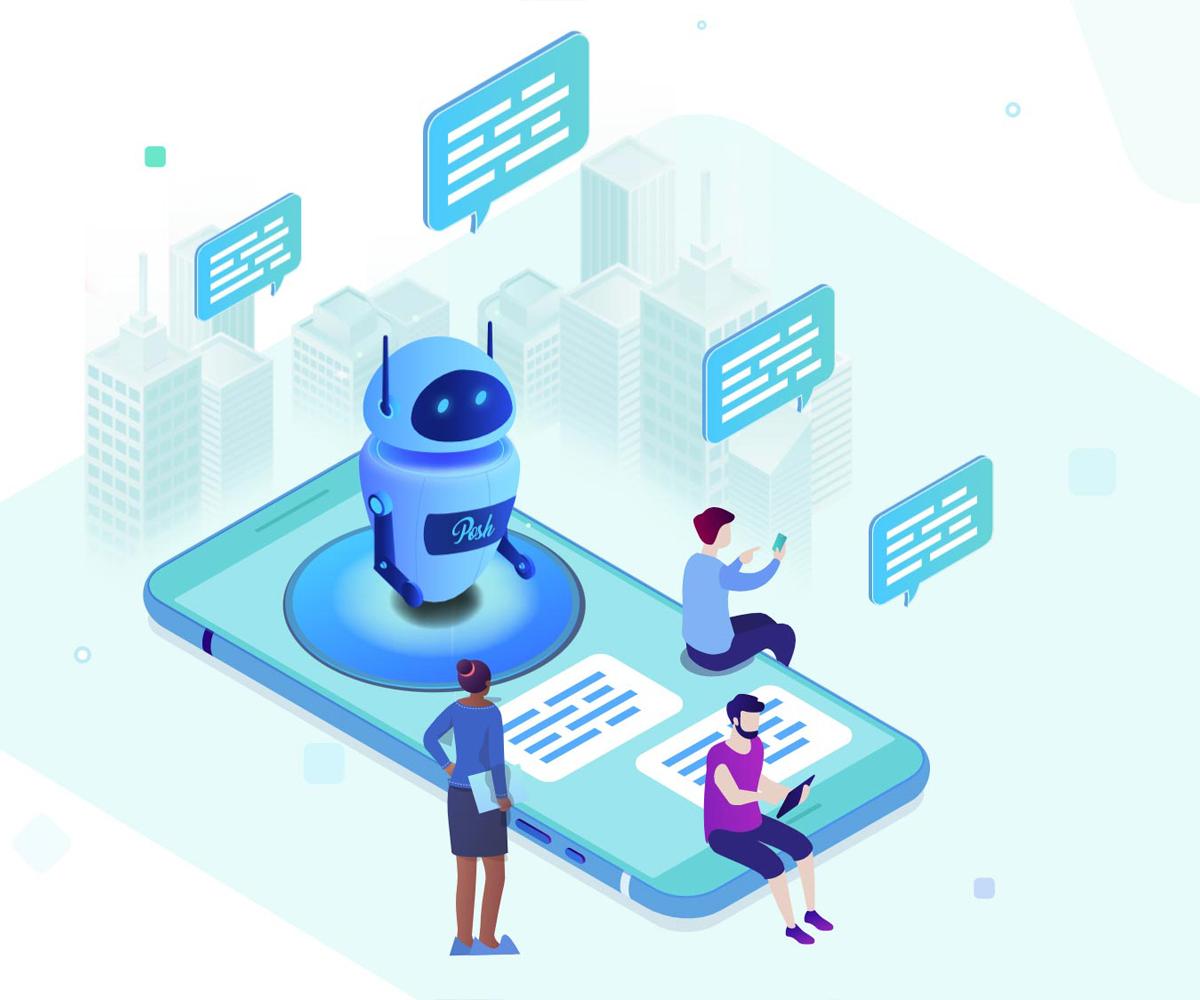t’s a fact that no business can survive without competitive customer support and the bests of the sales pitches. Enjoying an online presence itself means competing with thousands of other businesses like you, and you can’t compete with them without cutting-edge automation, all in terms of marketing, sales, and customer support. For a much extended time, we have been trusting traditional channels to stand out in the market, and these channels have accomplished an excellent job.
Take email for instance. It has been a precious asset in our hands, allowing us to put the same into everything from marketing, pre-sale, post-sale, to handling the queries and customer grievances. Email still is one of the broadest channels for customer support.
“Enjoying an online presence itself means competing with thousands of other businesses like you, and you can’t compete with them without cutting-edge automation, all in terms of marketing, sales, and customer support”
Moving into an era of chatbots from emails
Today, as we are on the verge of saying good-bye to 2019, we can’t deny the fact that the market has gone immensely competitive. Businesses are relying on more than just traditional channels for marketing, re-marketing, sales, and even for customer support and all kinds of post-sales relations.
Businesses currently are operating in a 24×7 environment and making sales around the clock. Hence, its fair customers now expect businesses to entertain them around the clock. Subsequently, businesses sought alternative with live chat support, where dedicated live chat executives working in shifts handled the chats 24×7.
Nevertheless, this did not last long, as human executives were susceptible to errors and fatigue. Not every business could afford to hire the workforce for a 24×7 environment. Even if some business could hire chat support executives working in different shifts, it was just impossible for humans to receive, process, and handle data-extensive chats as quickly as customers expect them to be. Besides, it was not possible to maintain perfect sync between the chats that different executives handled in different periods of their shifts.
Gradually, the technologies evolved, and we entered the era of Artificial Intelligence and machine learning, which paved a path for what we call them today, AI chatbots. AI chatbots addressed the gap by not only handling customer support but also assisting businesses in marketing, sales, and lead generation. Although we still use manual live chats for several errands, chatbots have efficiently shared the majority of loads from the human executives.
Perfect channel for 24×7 customer support
We saw decent improvement in terms of customer support around the clock with event-based chatbots, where they would respond to the queries using keyword identification. However, with keyword identification, we could not handle the contextual queries: Take the following query for instance:
Query_1: “I want to know my order status”
If the business has put a keyword identification of the phrase “order status”, the event-bot chatbot can easily understand the context of the query and respond.
Now consider the following query:
Query_2: “I ordered an iPhone a week ago. Could you tell me about its arrival at my condo?”
This is indeed an order status query, but the user has not used the identified keyword at all. The context of this query is the same but not the way two users have used it. That’s where the event-based chatbot fails to identify the query itself.
The second query is relatively complex for an event-based chatbot, and it demands human intervention. However, if it were an AI-based eCommerce chatbot, the Natural Language Processing (NLP) and deep learning would have allowed it to understand the context of the query and respond to it efficiently
NLP allows AI chatbots to comprehend languages in their standard form as used by a common person, while deep machine learning lets them learn new keywords by analyzing the altered forms of queries. After a while of learning, AI chatbots can independently handle queries 24×7 without any manual intervention, proving as an ideal companion for businesses in the end.
Seamless switching between human and AI executives
Even the most advanced AI developed until date does not have an IQ more than a 4-year-old kid. Undoubtedly, AI chatbots are still dependent and many times, they require human intervention. Despite better efficiency than humans to handle data-extensive queries around the clock, sometimes, businesses need human intervention for some of the tasks.
Let’s say, a customer stresses talking to a human for some complex negotiations. Making as a seamless bridge between AI and Humans, you can program your chatbot to connect the users with human executives in certain situations. Unlike event-based chatbots, AI bot will not keep on declining the chat for unidentified keywords.
Caption: AI-bots can learn when to call their human counterparts in certain situations.
Respond to data-extensive queries quicker than humans
If chatbots need human intervention in certain situations, humans require chatbots’ assistance even badly in most of the circumstances. Take data-extensive queries for instance. Chatbots can read, process, and respond to such queries more efficiently than their human counterparts respond.
For example, if a customer asks for order status, the human executive will initially look for the customer id from the CRM, and then filter out the specific order from a list of all previous orders placed by him or her. Then, the executive would track the status and type a response.
However, an eCommerce chatbot would handle this situation far quicker. You can connect your chatbot with your CRM, Inventory Management System, and your website’s dashboard. Utilizing this connection, the bot will instantly collect the data from the concerned repositories and respond in no time..
Generate leads and push sales pitch for immediate conversions
E-Commerce sites use chatbots to offer live support and guided shopping experience to the visitors. The objective is to guide the visitors so that customers do not leave the site out of any confusion. Chatbots complement the eCommerce stores and help them to handle the situations that lead to shopping cart abonnements.
Take the following situation for instance:
A customer was seeking a certain product on the website but could not find in the search results. In normal circumstances, he or she would jump from the site and look for it somewhere else. However, if there is a live chat support power by an AI-bot, the visitor may ask it if the product is available.
Presumably, the user was not using a proper keyword to search the product. Ideally, you should have handled your website search for identifying all types of keywords, but your chatbot saved you here from losing a conversion due to a fault in your website.
There are AI-powered eCommerce chatbots that function as a sales executive. Using deep learning, they can handle queries in direction to transport your visitors into your conversion funnel. They can automate the guided shopping environment on your website and boost user engagement. With a proper connection with your CRM and Inventory Management system, they can push back in stock, price drop alerts, and sales pitches to your potential customers.
AI represents a perfect technology for your retargeting campaigns, and chatbots play the most crucial role in it as a seamless channel for communication. Check out how the following AI chatbot is supporting the customer to discover an appropriate product:
Caption: Guide shopping with AI chatbots is the future of eCommerce
Automation of the business processes to refine inclusive efficiency
Apart from serving as a seamless customer support channel, marketing channel, and sales executive, businesses are using AI bots to sort their business processing tasks as well. Certain bots can integrate inventory management systems to maintain a track of stock and alert the concerned department when it’s time for re-stocking.
Besides this, businesses are automating a plethora of tasks with AI bots, which otherwise demand a significant amount of time, money, and effort for humans to do it. Furthermore, these bots can handle extensive calculations leaving no chance for error, which is not the case when relying on the manual workforce.
Businesses are using chatbots as user acquisition tools, marketing tools, sales tools, re-engagement tools, business processing tools and much more by connecting them with their- websites, mobile applications, CRM, PIMS, ERP, E-GRC, Ticket management, E-mail marketing, and Push marketing tools.
· Better Live chat experience
A study by Kayoko suggests that eCommerce customers feel more connected to real-time support than traditional human live chats. As AI chatbots can respond quickly and accurately, traditional live chat tools can’t compete with them. Besides, businesses can save a lot of costs required to maintain dedicated executives on traditional channels. An AI bot triggers better live chat involvement with users with quick responses, lesser groundwork, no errors, and precise handling of a massive amount of data spread across multiple systems.
· Automating Content Marketing
AI bots can automate most of the content marketing tasks for marketers. They can generate personalized content for individual users based on their search intent. With predictive analysis, data filtering, they can serve useful content to the users as per their queries. With time, they can learn and advance into comprehending complex customer desires and preferences and guide content traffic into your sales conversion funnel. They can even automate the entire process of newsletters subscriptions for instance.
Caption: Feeding micro-personalized content with the help of chatbots
· Driving traffic from Social media sources
Facebook’s messenger is an example of one of the best AI chatbots we have around these days. A considerable number of businesses have integrated it on their websites and mobile applications. One of the most crucial reasons for the massive popularity of this chatbot is its background –Facebook. A platform inhabited by billions of user accounts is already an enormous repository of data, which is a fuel AI. This chatbot can not only function a live chat on your website but also drive qualified leads from your Facebook page too. As 64% of Facebook users already use Facebook Messenger, you can gain access to an instant communication channel through Facebook Messenger bot. This tool has the power to serve users in the most micro-personalized way any other chatbot can do.
Caption: Access to a seamless communication channel and a massive repository of data with Facebook Messenger bot
· Direct selling and converting leads into customers
H&M uses Kik’s Bot Shop to encourage direct sales through its live chat window. Using web-views for a product page, the chatbot returns personalized views of the product pages in the messenger window itself. Besides, it serves all kinds of crucial information to the customers such as product reviews, descriptions, and multiple product pictures, etc.
Caption: Guided shopping with direct selling features on H&M’s chatbot is a gem for the business
A customer seeking help from the chatbot in their product research need not go to the respective product pages to complete the finalized purchase. The bot can assist such customers to checkout from the messenger interface itself. Besides, the bot also feeds the after-sales information right in the same window, which allows customers to track their purchase information, order status, and ETA of the delivery upfront.
· Converting abandoned carts with micro-personalization
AI-powered eCommerce chatbots such as Facebook Messenger bot can curb cart abandonments through upfront micro-personalized communications. Unlike emails and SMS, the messenger bot need not worry about spam folders. You can take a sue from how Cole Haan used AI to combat abandonments via it’s Facebook Messenger bot. The bot recognizes unique circumstances to trigger appropriate offers and discounts to the users.
Caption: Micro-personalized abandoned cart recovery through AI chatbots
It not only triggers automatic abandoned cart reminders but additionally implements direct selling to covert the customer right within the messenger window, as explained in the previous section. By ensuring negligible friction in the conversion process, the Chatbot constructs a personalized funnel for specific users, which establishes the route from abandoned carts to final checkout seamless. The bots know when to club a discount coupon to present a compelling case in front of the target customer.
· Upselling and Cross-selling with micro-personalized recommendations
With all that massive repository of data and Analytics of consumer behavior, AI chatbots can trigger micro-personalized recommendations to upscale overall cart values. They can upsell and cross-sell highly related products.
Caption: Chatbots have unlimited ways to leverage data as a tool for upselling and cross-selling
It easier for eCommerce chatbots to access, process, and analyze a customer’s purchase history and put a highly targeted recommendation for the subsequent purchase. Even the new chatbots, who don’t have legacy customer data, can trigger quick questionnaires, and conduct quick analysis to offer personalized suggestions.
Feed your CRM to your chatbot
AI chatbots are no different from event-driven bots without data. They need data to learn, evolve, and become autonomous of the manual intervention. Unless you feed your auxiliary systems like CRM, PIMS, TMS, and others to your chatbot, it cannot help you with data-driven assistance. Let your chatbot feed on your customer data, market research data, purchase histories, social media data, etc. to make the best use of it. The more is the data, the more it learns, and the perfect it gets with precise responses.
That’s why my last tip for you would be being careful with access control of your chatbot. You need to ensure you can trust the vendor of your chatbot before granting this unlimited access of your business data to the chatbot.
Don’t let the human touch go away…
Finally, no matter how smart these bots get, they cannot replace humans completely. Hence, never let the human touch vanish from your chats. Let your users know you are using a chatbot, but you are also present with manual assistance if required. Monitor your chatbot constantly and go for a rapid transition from bot to humans, if it starts aggravating your clients with imprecise replies. Human intervention is imminent, at least until the bot goes through enough data and machine learning to come into it’s full-fledged.



